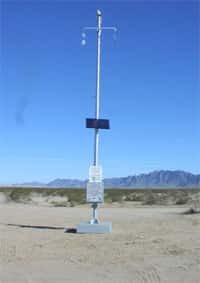Secure Border Initiative Part 4
Boeing was awarded the Secure Border Initiative contract while admitting to having no experience in border security.
Boeing’s Network of Integrated Technologies
Boeing is a technology company. They manage, and sell, and maintain … Technology. The solution to any problem put before them is … Technology.
Boeing is moving portable observation /surveillance towers into the border zones to act as temporary or prototype observation posts. Once the optimum spots for the towers have been determined then permanent towers will be installed. These towers can have remotely operated day and night vision cameras and even radar systems on them. The towers can also have certain digital radio relay systems mounted on them that allow the border patrol agents to communicate more easily with their sector headquarters and to send and receive more information than is possible over their standard hand held radios. Some of this is very good because the agents will have fewer communications dead zones (just like with your cell phone) and this can be good when they are calling for help.
The Big Problem
Boeing somehow missed is that to put a camera tower — portable or not — along the border you have to have legal access to the land. You also have to have an access road. You also have to have done some pretty strange and expensive environmental and archeological studies of the area to make sure the area does not have some broken arrowhead buried on it that some Native American tossed away 300 years ago or that the truck you plan to use to deliver lunch to the workers passed it’s last smog check (really). If you simply try to ignore such rich gems of archeological and environmental diversity there are lawyers and lawsuits waiting for you. If you doubt this … return to the example of Tijuana,
above … Or look at the following document’s table of contents.

Here is the table of contents for a 246-page document (one of five different documents that are required) to allow the Border Patrol to simply place a Rescue Device (photo on right) on the ground in the desert to allow illegal aliens, drug smugglers, and even terrorists to call for help — if they get lost in the American desert.
The Border Patrol isn’t digging for oil, or building a Yucca mountain nuclear waste repository … they are gently placing a block of concrete on the surface of the ground that has a flag pole and call button that goes to a radio that lets those in need call for help in the desert.
These reports cost about $1,000 a page to create. There could easily have been over a million dollars spent on the environmentalist lawsuit mandated
research and paperwork just to keep from being sued for placing that thing on the surface of the ground to try to save smugglers and even terrorists who are wandering around in the desert.
Just that one document detailed above fills 21 megabytes of disk space. The entire CIA World Fact Book is only about 100 megabytes of disk space.
So when you see people protesting about somebody dying in the desert keep in mind that it’s those very same people who sue when the Border Patrol tries to put rescue devices in the desert to save those lives.
It gets worse. If you examine Page Two of that document — items #4 and #6 — you will note that under the agreement
the Border Patrol is required to stay away from hundreds of square miles of border lands. Yes, to be allowed to place rescue devices on the ground to save lives the Border Patrol had to promise the environmentalists
to restrict its own surveillance of the border. It’s fine with the environmentalists
if the place becomes a drug smuggler’s Freeway To The North but just don’t let the Border Patrol go there.
This is the sort of stuff
Boeing did not bother to investigate before they bid on this SBI-Net fiasco.
The environment
not withstanding … another problem seemingly missed by Boeing is that there really aren’t that many places along the border where camera towers will work. Much of the border terrain is far too craggy and has too many deep narrow canyons to make video cameras an effective solution.
Border Access
The U.S. border itself offers a simple east west roadway that is met every few miles by a north south roadway. Almost all of these roads are dirt roads — not all-weather roads. If your tower
cannot fit on the existing right of way or easement or land you already bought, you are in trouble. Further, the ideal spot for your tower might not be anyplace you can actually use without five years of government acquisition procedures plus ten years in court with the environmentalists
and then a million dollars in all-weather road construction.
